
Orange trees and their delicious fruit are not native to North America, but they form a curious and poorly-remembered chapter in South Carolina’s early history. During the second quarter of the eighteenth century, British settlers planted thousands of orange trees in the Charleston area to capitalize on the fruit’s high commercial value. Although cold temperatures ended dreams of an orange bonanza before the American Revolution, vestiges of Charleston’s colonial citrus experiment survive on the modern landscape.
The fruit identified in English as the orange originated within the warm, humid climate of southeast Asia. Oranges and orange seeds, like many other valuable commodities, followed ancient trade routes from Asia to the west, reaching warm southern Europe at least six hundred years ago. Numerous hybrid varieties exist today, but British colonists residing in South Carolina during the seventeenth and eighteenth centuries identified two types of oranges—the sweet or “China” orange, and the sour or “Seville” orange, known today as the bitter orange. The popular breakfast beverage flows from the sweet variety, while the classic British orange marmalade is made from the bitter variety.
Spanish adventurers sailing with Christopher Columbus in the 1490s planted orange seeds on various islands in the Caribbean Sea. Subsequent voyages during the first half of the sixteenth century brought waves of Spanish explorers to the mainland territory now identified as Florida, Georgia, and South Carolina. Following the settlement of St. Augustine in 1565, Spanish clerics established a series of mission communities along the Atlantic coastline extending northward as far as Santa Elena, now Parris Island, South Carolina, in Port Royal Sound. All of these cultural endeavors fostered the introduction of various Old World flora and fauna to the southern colonies, including horses, cattle, hogs, peaches, and oranges.
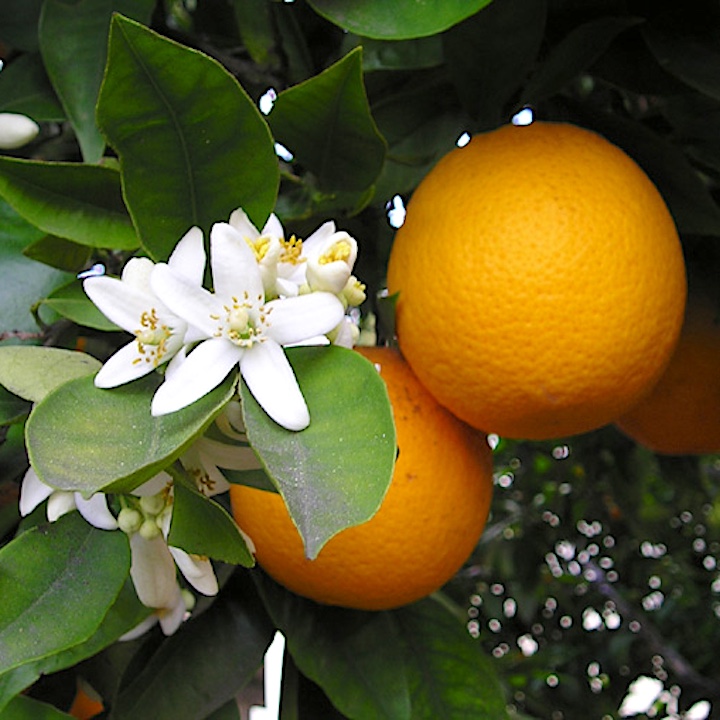
Meanwhile, people in the cooler climes of England procured oranges and other citrus fruit through trade with Spain and Portugal. Their appetite for oranges increased during the middle years of the seventeenth century, coincidentally, following the establishment of several English colonies in the Caribbean, including Barbados, Antigua, and St. Kitts. The growth of profitable sugarcane plantations on these islands fostered the advent of rum production, which in turn fueled a rise in the consumption of a cocktail commonly called “punch.” Mixing sweet rum with sour oranges and lemons, Caribbean colonists created a drink that became popular among affluent gentlemen in England and its mainland colonies in North America. An example of this phenomenon survives in a once-popular but now-obscure drinking song and dance tune first published in London in 1657, called “Oranges and Lemons.” Highly decorated ceramic punch bowls from the seventeenth and eighteenth centuries also survive in museum collections across the former American colonies, testifying to the widespread popularity of rum punch among affluent drinkers.
The English settlers who established South Carolina during the 1670s found an unknown quantity of orange and peach trees scattered within the coastal Lowcountry, vestiges of earlier Spanish exploration and attempts to settle. Carolina colonists of the late seventeenth century might have harvested their fruit and planted additional trees for their own enjoyment, but few details of their agricultural efforts survive. At any rate, we know that fruit-bearing orange trees existed in some appreciable quantity in and around Charleston during the early years of the eighteenth century. British naturalist Mark Catesby, who arrived at the port of Charleston in 1722, provided a useful summary of the local orange culture in his 1731 book describing the colony’s flora and fauna: “Carolina being the climate which produces the best oranges and lemons in the old World, they might therefore be expected to abound here; but the winters in Carolina being much more severe than those in parts of Europe in the same latitude, these trees are frequently killed to the ground by frost. Yet when they are planted near the sea or salt-water, they are less liable to be injured by frosts, and bear successive crops of good fruit.”[1]
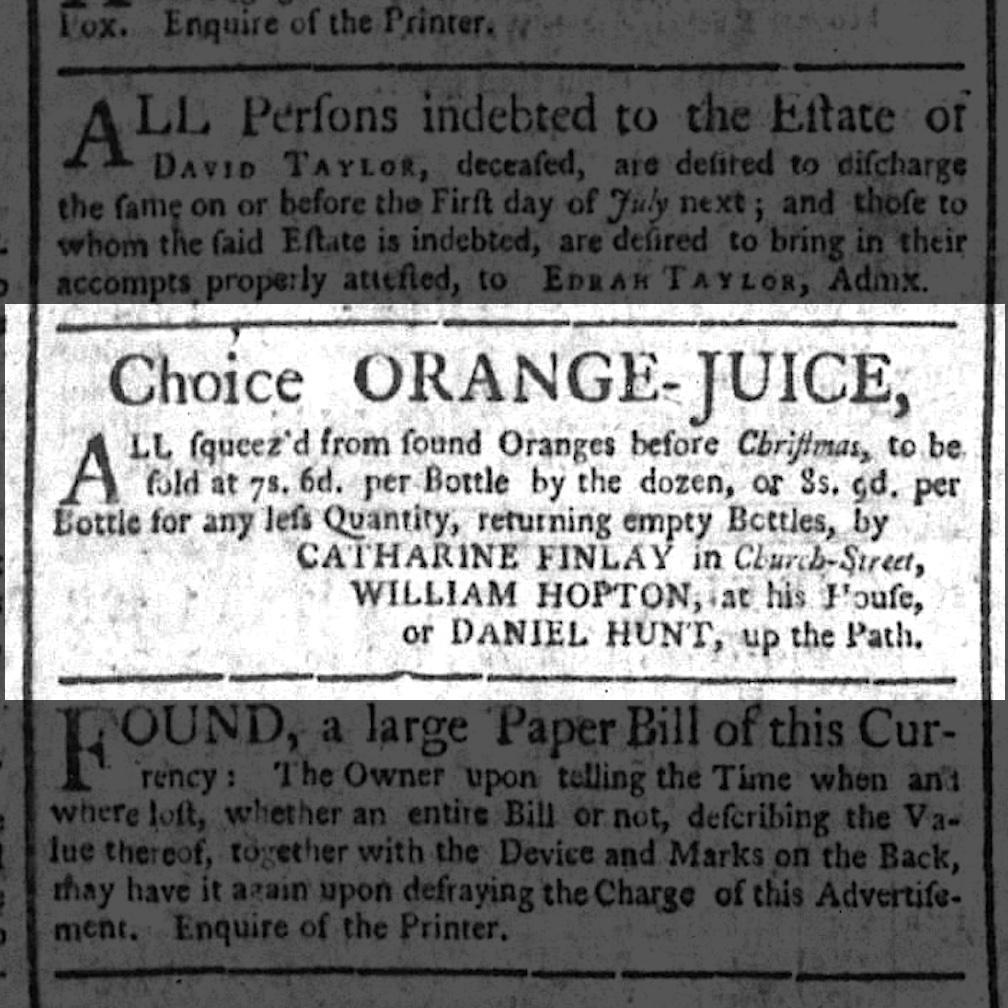
Although we know little about the cultivation of orange trees in early South Carolina, we can discern an era of active propagation and marketing during the second quarter of the eighteenth century. The principal factor driving this phenomenon was profit: oranges and other citrus fruits were considered valuable commodities in the trans-Atlantic economy of the colonial era. Details surrounding the local genesis of this movement are now obscure, but the advent of weekly newspapers in Charleston in 1732 provides firm documentary evidence of the local orange economy. At that time, rum distilled in the Caribbean and in the Northern colonies was ubiquitous and cheap, while citrus juice in general was scarce and expensive. Just about anyone from common sailors to affluent gentlemen could afford to drink rum, but only those at the upper end of the economic spectrum could afford to flavor their punchbowls with oranges, lemons, and limes.
In 1732 Charleston, for example, the price of one hogshead (63 gallons) of Boston rum fluctuated between twelve and fourteen shillings in South Carolina currency. For that same price, one could purchase a gallon of imported wine, or slightly less than one gallon of imported lime juice.[2] Between 1738 and 1741, locally-produced oranges sold for fifty to sixty shillings currency per hundred. At those rates, one could trade approximately two dozen oranges for a hogshead of rum. A single orange, therefore, was roughly equivalent to the price of a small loaf of bread, or one hour’s wages for an enslaved laborer.[3]
The earliest documentary evidence of the local orange boom survives from the late winter of 1733, when ships from London brought settlers to establish the neighboring colony of Georgia. The British trustees funding that venture sent two gardeners to establish an experimental garden in the nascent town of Savannah, hoping to determine which profitable crops might flourish in the new province. While one of the two professional gardeners accompanied the bulk of the Georgia settlers to Savannah, the other, an Italian named Paolo (Paul) Amatis, remained in urban Charleston. Here he rented a house standing on a swath of land to the west of modern Orange Street, extending southward from Broad Street to Tradd Street. Within this compass of approximately 1.5 acres, located just outside the footprint of Charleston’s fortified walls then being demolished (see Episode No. 268), Amatis and a team of laborers planted a dense field of imported fruit trees.[4] Mulberry trees intended to jump-start a proposed silk industry dominated the garden, but orange trees numbering approximately five hundred formed a close second.[5]
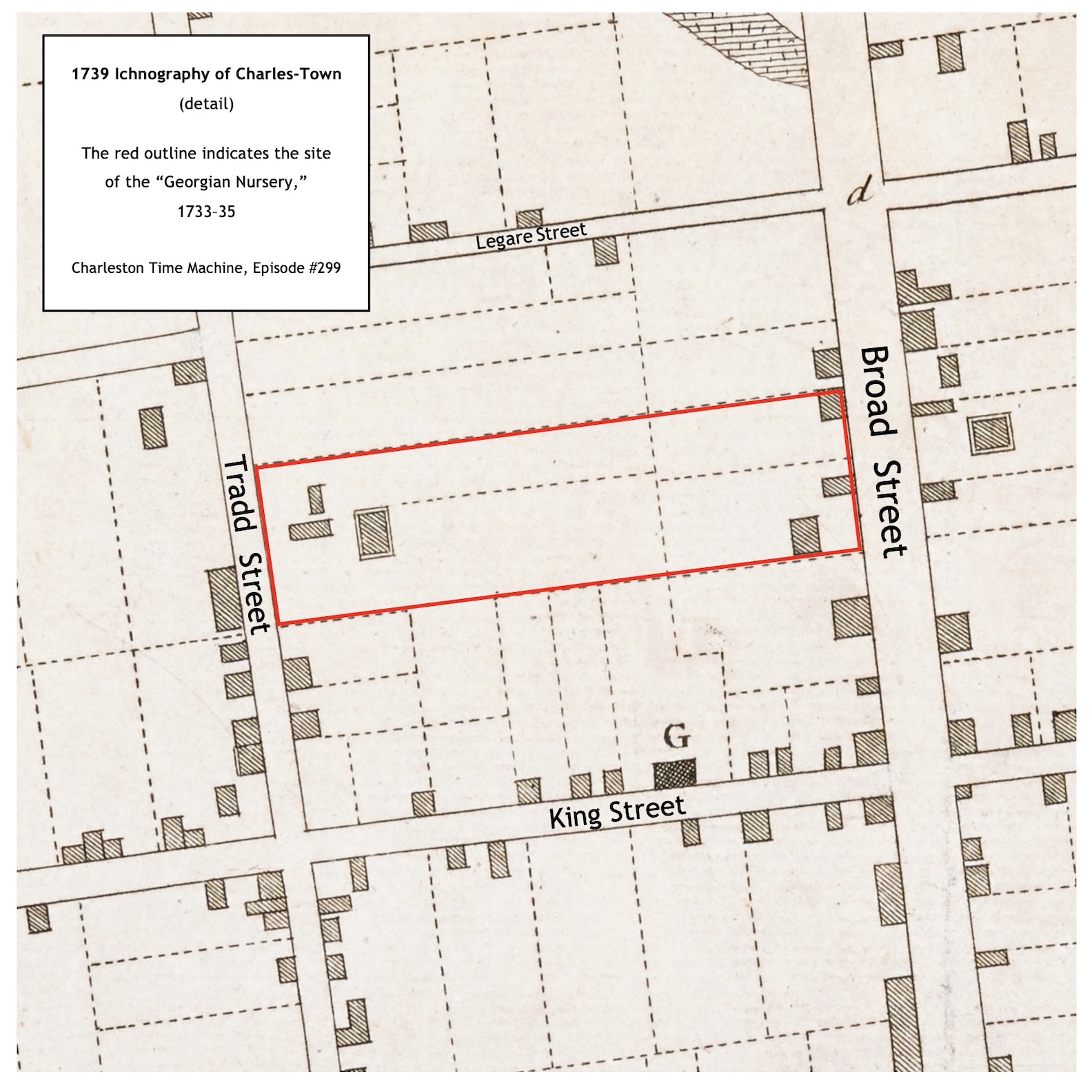
Back in Savannah, a settler named Elisha Dobree provided a brief explanation for this interest in oranges. In a 1734 letter to the Trustees of the Georgia Colony, he reported that the annual value of the fruit from a single orange tree in Charleston amounted to £5 sterling. That figure probably represents a misunderstanding, and more likely was supposed to represent the tree’s value in South Carolina currency (i.e., one-seventh that of sterling).[6] Regardless of his precise meaning, Dobree correctly conveyed the notion that oranges held considerable valuable in Charleston and beyond. To transfer that value to the nascent colony of Georgia, Paul Amatis and his servants uprooted and transferred thousands of saplings from his Broad Street garden to the experimental garden in Savannah between September 1734 and February 1735.[7] Immediately thereafter, an advertisement to lease the newly-vacant property “at the upper end of Broad Street” identified the site as “the same ground whereon the Georgian Nursery of trees were raised by Mr. Paul Amatis.”[8]
The evacuation of the Georgia garden in Broad Street removed hundreds of orange trees from urban Charleston, but a significant number remained on the local landscape. The texts of numerous real estate advertisements published in the South Carolina Gazette during the 1730s and beyond testify to the distribution of fruit-bearing orange trees within the capital town and across suburban and rural plantations. A 1734 advertisement for the sale of Hog Island, on the east side of the Cooper River, for example, mentioned the presence of orange and other fruit trees.[9] A large “orange grove” stood within a colonial-era plantation on the west banks of the Ashley River, immediately north of Charles Town Landing State Historic Site, at the eastern terminus of modern Orange Grove Road.[10] A 1737 advertisement for a house and lot at what is now the southeast end of Society Street identified the property as “the Orangery.” That appellation probably inspired the site’s alternate nickname, “Petit Versailles,” which first appeared a few years later.[11]
Another significant site of local orange cultivation was the suburban estate of Captain George Anson of the Royal Navy, whose Bowling Green plantation was later subdivided and rebranded as Ansonborough. Anson purchased the 100-acre site (encompassing high land and tidal marshland) in 1727, at which time the deed of conveyance contained no mention of oranges or any other fruit trees. By the time he sold the property decades later, however, the property was said to include a house and various outbuildings as well as an “orange grove” and garden.[12] Anson left no documents to explain when he planted these orange trees—either before, during, or after the cultivation of the “Georgian Nursery” on Broad Street—or why he undertook such work. It seems unlikely that he understood the nutritional value of citrus juice as a cure for scurvy, although he might have intuited such a connection before his famous voyage around the world in 1740–44, during which three quarters of his crewmen perished from the dreaded disease. Contemporaries of Captain Anson “averr’d that he loves his bottle,” however, leading me to suspect he developed an orange grove at his home, across the street from the “Orangery” at Petit Versailles, to profit from the popularity of rum punch among his genteel neighbors.[13]
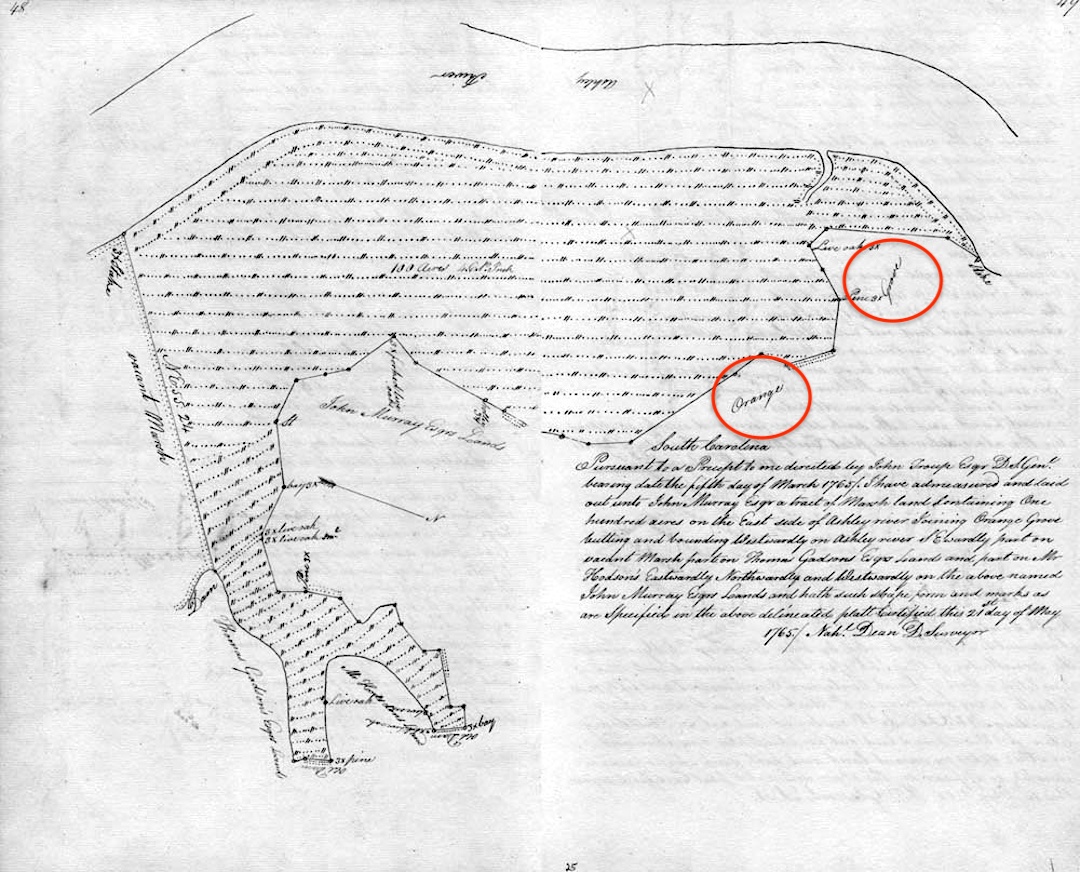
Despite the surge in orange cultivation across the Carolina Lowcountry during the 1730s, the vagaries of the local climate tempered the market’s potential profits. As early as 1737, Charlestonians saw one year’s worth of orange profits disappear with plunging temperatures. “Our winter has been so severe,” wrote an anonymous correspondent that March, “that the frost has so far killed our orange trees, that they will not bear this year, which is no small grief to us.”[14] The trees eventually recovered, but the local demand for citrus far outstripped the local supply. In the one-year period from November 1736 to November 1737, for example, South Carolina imported more than one million limes, lemons, and oranges.[15]
Most of the oranges grown in early South Carolina were likely consumed by local inhabitants and perhaps occasionally traded for various goods and services. That model of consumption began to change in late 1739, when the advent of a new war between Britain and Spain, now known as the War of Jenkins’ Ear, interrupted commerce between the two nations and their respective colonies in the Americas. Folks in Britain and the in the British-American colonies found it difficult to procure oranges and lemons to flavor their punch during the 1740s, driving prices higher during the decade-long war. At the same time, profits from rice dropped as insurance rates on trans-Atlantic shipping rose, and South Carolina’s provincial government offered cash incentives to stimulate experimentation with other crops such as ginger, indigo, sesame seeds, hemp, and flax. Oranges were not eligible for the government bounty, but Lowcountry planters continued to cultivate citrus trees to capitalize on the market scarcity.
The first commercial exportation of oranges from South Carolina occurred in the autumn of 1744. In August of that year, before harvest season commenced, Charleston merchant Robert Pringle described the new venture to a friend in Boston: “As this province has been for some years past improving in the planting of orange trees, especially in this town & about it, so now they have brought them to such maturity that this year a very considerable quantity of oranges are produc’d, insomuch that a pretty many will be export’d this fall to the northward. . . . The oranges produced here are esteem’d very good and large & much exceed any in Europe or the West Indies[,] being of the sour or Seville kind.”[16] To extend the shelf-life of the oranges shipped abroad, producers in South Carolina and elsewhere routinely picked the fruit in the early autumn, while still green, and allowed them to mature while in transit to a marketplace.[17]
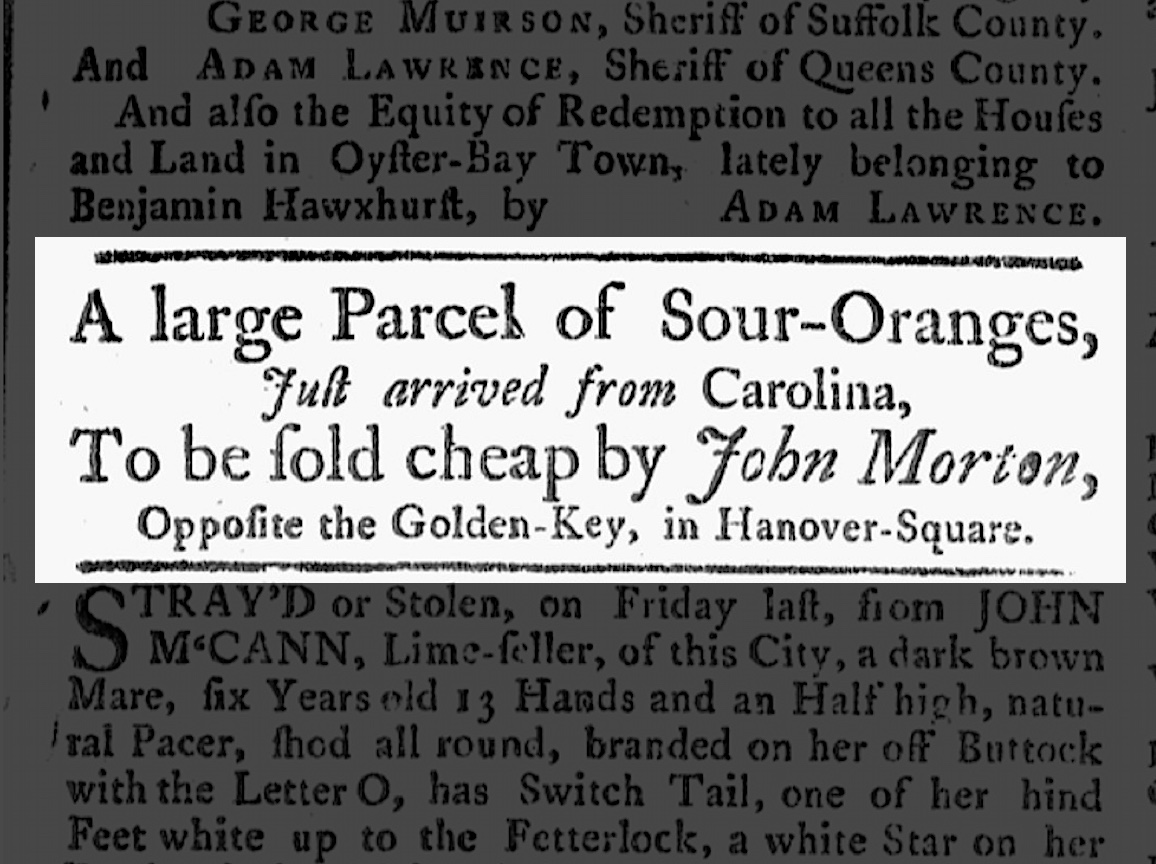
In October 1744, Robert Pringle sent twenty-four chests containing a total of 13,100 oranges to a merchant in New York. To the recipient he described the fruity cargo as “the first essay of a tryal [sic] for exportation from this province,” which Pringle hoped would “meet with good encouragement[,] so as an annual exportation of [the] same may be continued.” The Charleston merchant also identified the producers of the oranges in question as the brothers Charles and Jermyn Wright, sons of the late provincial Chief Justice, Robert Wright. Coincidentally, the Wright brothers were at that time renting the house and orange grove belonging to George Anson of the Royal Navy.[18] Oranges were evidently so numerous in Charleston in late 1744 that Pringle could not sell a cargo of lime juice imported from Barbados. He apologized to the owner of the cargo, stating that “oranges being now produc’d here in great plenty makes it no ways saleable.”[19]
At the end of the decade-long war with Spain, South Carolina Governor James Glen reported to the British Board of Trade that the colony had exported a total of 296,000 oranges from the autumn of 1747 through the following summer.[20] That figure represents the first peak of Charleston’s orange export trade, followed by a dramatic downturn. In mid-February 1748, temperatures in the capital briefly dropped to a reported ten degrees Fahrenheit, causing extensive damage to budding trees across the region. Governor Glen later reported that the frost “destroyed almost all the orange trees in the [Low]country,” and, at his residence on Charleston Neck, later called Belvedere Plantation, Glen “lost three hundred [fruit-] bearing trees.”[21] A young merchant named Henry Laurens confirmed the effects of the 1748 frost in a letter to a friend in Boston: “We have very lately had a severe frost which in one night has to present appearance destroy’d all our orange trees, so that I fear we shall have none of that fruit of our own growth for two or three years hereafter. . . . Since that frost[,] the price [of oranges] is advanc’d 100 per cent & but few to be had any where.”[22]
Another severe frost during the late winter of 1752 killed more orange trees in the Charleston area and reportedly as far south as St. Augustine, Florida, but the trees recovered, and the volume of local fruit exported gradually increased throughout the decade. [23] Then a new war between Britain, France, and Spain, known in the colonies as the French and Indian War, commenced in 1756 and again disrupted trans-Atlantic commerce. Coincidentally, the volume of oranges exported from South Carolina to the Northern colonies surged during the latter years of the war. This trend reached a peak in the autumn of 1761, when the total number of oranges exported from Charleston exceeded 350,000 pieces of fruit.[24]
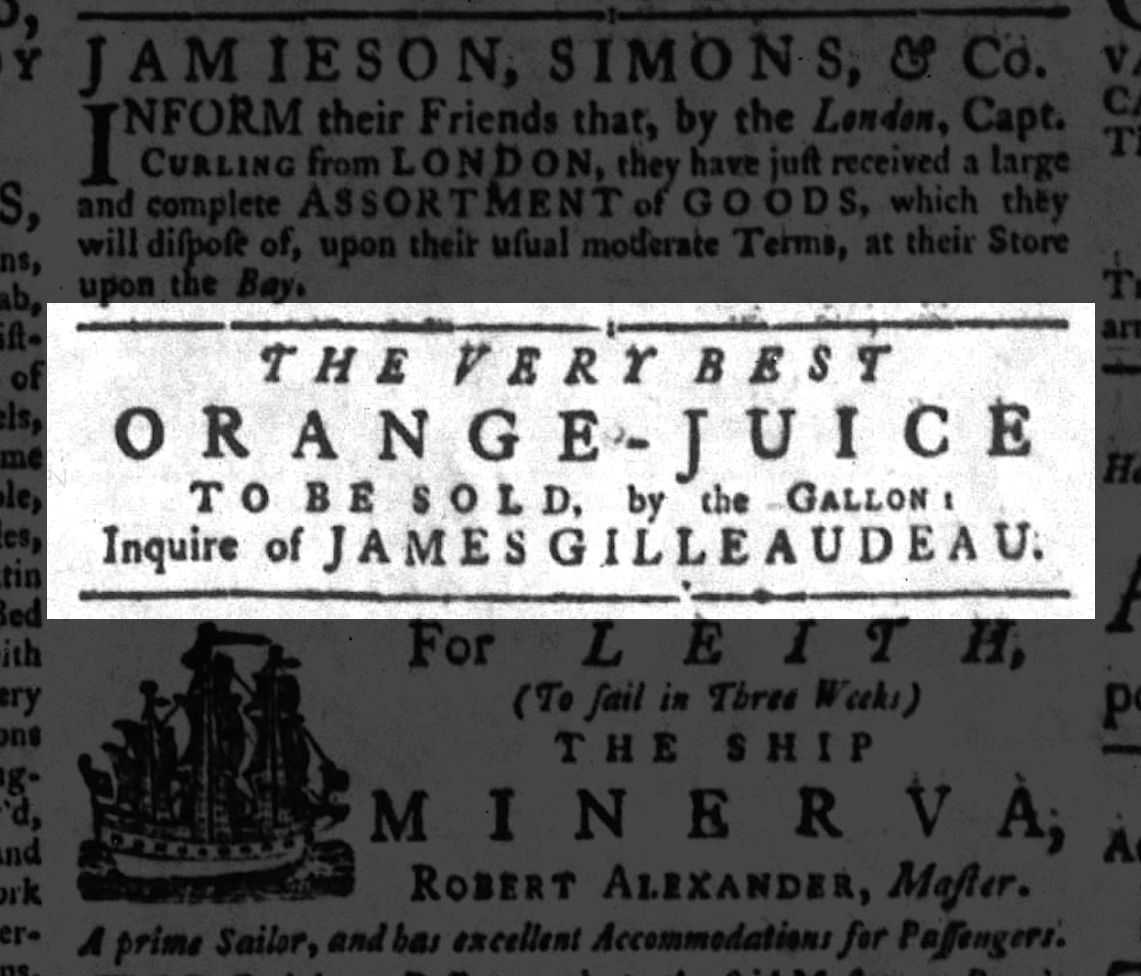
South Carolina’s orange economy reached a significant turning point at the conclusion of the French and Indian War, also known as the Seven Years’ War in Europe. After British forces laid siege to the Cuban capital of Havana in 1762 and captured the island, Spain agreed to cede mainland Florida to Britain in order to regain possession of Cuba. The warm and fertile colony of La Florida, first claimed by the Spanish Crown in 1513, became a British possession in 1763. From that point onward, British subjects in the American colonies enjoyed easy access to orange and other citrus fruit grown within Florida’s more amenable climate. Orange exports from Charleston declined progressively over the next dozen years to a negligible measure at the beginning of the American Revolution.[25]
The War for American Independence disrupted the trans-Atlantic flow of oranges and other commodities from British colonies like Florida, the Bahamas, and elsewhere in the Caribbean, while Spain and its American colonies continued to export citrus fruits. In the latter stages of the Revolution, Spain unofficially joined the nascent United States and France in the fight against Great Britain. As part of subsequent peace negotiations in 1783, the British government relinquished Florida back to Spain. Thereafter, commerce between each of the United States and British and Spanish territories in the Caribbean began to flow with relative freedom. In the post-war, early-national period of our history, imported oranges and other fruits far outnumbered those gathered from local trees. South Carolina’s climate limited its ability to compete with orange producers like Florida, while the advent of profitable cotton production in the 1790s inspired Lowcountry planters to invest their time and money elsewhere.
Spain sold its Florida territory to the United States government in 1819, and the Sunshine State officially joined the federal union in 1845. Orange production there accelerated greatly during the second quarter of the nineteenth century, just as it had in the South Carolina Lowcountry a century earlier. This activity established the foundation of Florida’s modern orange industry, which, combined with that of sunny California, now supplies the rest of the nation with vast quantities of citrus fruit.

The volume of oranges and orange juice exported from South Carolina during the colonial era formed a relatively small proportion of the province’s total agricultural produce during the decades in question, but the endeavor nevertheless forms an interesting part of the state’s early history. Groves of flowering orange trees no long perfume the air of Charleston and its environs, but astute observers can still spot a few wild orange trees in the city and across the Lowcountry landscape, producing bitter fruit ready for harvest near the onset of winter.
The most significant vestige of Charleston’s colonial orange boom survives within the heart of the old capital. Stretching between Broad and Tradd Streets, the “Georgian Nursery” rented by Paolo Amatis in 1733–35 became the home of the Free School of St. Philip’s Parish in the early 1750s. A vintner named Joseph Wilson transformed the house into a tavern in the spring of 1761 and marketed the establishment as the “Orange Garden.” That name endured for several years under a series of proprietors, and the site’s colorful career as a popular pleasure garden merits a future program of its own. To conclude the present conversation, however, I’ll draw your attention to the garden’s demise. Alexander Petrie purchased the Orange Garden in October 1767 and immediately divided the 1.5 acre lot into a dozen smaller lots. At the same time, Petrie sacrificed a strip of land along the eastern edge of the garden, twenty feet wide, to form Orange Street.[26] Perambulating the length of Charleston’s Orange Street, is, therefore, an exercise in time travel. Fortified with a knowledge of the community’s citrus history, one might even detect a fragrant hint of ancient orange blossoms in the air.
[1] Mark Catesby, The Natural History of Carolina, Florida and the Bahama Islands, volume 1 (London: by the author, 1731), xxi.
[2] See the prices current published in the South Carolina Gazette (hereafter SCG), 8–15 July 1732, page 4, and 18–25 November 1732, page 4.
[3] See SCG, 9 November 1738, page 2, “Whereas the 12th of last month was taken from my door.”; Inventory of the estate of Thomas Gadsden, 27 August 1741, South Carolina Department of Archives and History (hereafter SCDAH), Inventories of Estates, volume 1740–1743, pages 83–92; a number of statutes ratified by the South Carolina General Assembly around the middle of the eighteenth century calculated the wages of enslaved laborers as seven shillings and six pence, currency.
[4] Julie Anne Sweet, “A Misguided Mistake: The Trustees’ Public Garden in Savannah, Georgia,” The Georgia Historical Quarterly 93 (Spring 2009): 7–8.
[5] See the letters of Samuel Eveleigh to the Georgia Trustees, 18 May 1733, in Kenneth Coleman and Milton Ready, eds., The Colonial Records of the State of Georgia, vol. 20 (Athens: University of Georgia Press, 1982), 22.
[6] See Elisha Dobree to the Georgia Trustees, 17 October 1734, in Coleman and Ready, eds., The Colonial Records of the State of Georgia, 20: 85.
[7] See the letters of Samuel Eveleigh to the Georgia Trustees, 19 October 1734; Thomas Christie to James Oglethorpe, 14 December 1734; Paul Amatis, to James Oglethorpe, ?December 1734; Paul Amatis to the Georgia Trustees, 12 January 1734/5; Paul Amatis to James Oglethorpe, 21 January 1734/5; and Joseph Fitzwalter to the Georgia Trustees, 10 March 1734/5, in Coleman and Ready, eds., The Colonial Records of the State of Georgia, 20: 88, 124, 152, 186–87, 210, 212–13, 251–52.
[8] Compare the advertisements of Thomas Heyward in SCG, 13–20 January 1732/3, “To be lett, by Capt. Thomas Heyward”; SCG, 15–22 February 1734/5, page 3, “To be Lett A Town Lott with a Dwelling house and other Conveniencies”; Heyward did not own the property in question, but evidently acted as the agent for an unspecified owner.
[9] SCG, 2–9 February 1733/4, pages 3–4.
[10] The “Orange Grove” on the Ashley River appears in a plat by Nathaniel Dean, certified on 21 May 1765, in SCDAH, Colonial Plat Books (Copy Series)(series S213184), volume 8, page 48; a later copy of this 1765 plat is plat No. 8107 in the John McCrady Plat Collection at CCRD.
[11] SCG, 24 November–1 December 1737, page 4.
[12] Richard Lambton, attorney for George, Lord Anson, to John Rattray, lease and release, 26–27 April 1757, Charleston County Register of Deeds (hereafter CCRD), volume RR: 520–32.
[13] J. H., The Private Character of Admiral Anson (London: J. Oldcastle, [1747]), 18.
[14] New-England Weekly Journal, 29 March 1737, page 2, citing news from Charles Town dated 8 March 1736/7.
[15] Pennsylvania Gazette, 28 February 1737/8, page 2, “South Carolina. An Account of sundry Goods Imported, and of sundry Goods of the Produce of this Province Exported, from the several Ports of Charles Town, George-Town, and Port-Royal in South Carolina, from the first of Nov. 1736, to the first of Nov. 1737.”
[16] Robert Pringle to Thomas Hutchinson and Thomas Goldthwait, 18 August 1744, in Walter B. Edgar, ed., The Letterbook of Robert Pringle, volume 2 (Columbia: University of South Carolina Press, 1972), 732.
[17] See the essay on the consumption of alcohol and punch in Boston Weekly News-Letter, 17–24 February 1736/7, page 1.
[18] Robert Pringle to Jacob Franks, 4 October 1744, in Edgar, ed., Letterbook of Robert Pringle 2: 744–45. Details of the relationship between Anson and the Wright family will appear in my forthcoming biography of Anson.
[19] Robert Pringle to Edward Pare, 20 December 1744, in Edgar, ed., Letterbook of Robert Pringle 2: 786.
[20] Plowden Charles Jennett Weston, ed., Documents Connected with the History of South Carolina (London: by the editor, 1856), 88–89.
[21] Chapman J. Milling, ed., Colonial South Carolina: Two Contemporary Descriptions by Governor James Glen and Doctor George Milligen-Johnston (Columbia: University of South Carolina, 1951), 25, 36–37; David M. Ludlum, Early American Winters, 1604–1820 (Boston, Mass.: American Meteorological Society, 1966), 141–43.
[22] Henry Laurens to Thomas Savage, 4 March 1747/8, in Philip M. Hamer, et al., ed., The Papers of Henry Laurens, volume 1 (Columbia: University of South Carolina Press, 1968), 117.
[23] Pennsylvania Gazette, 30 April 1752, page 2.
[24] SCG, 10–17 October 1761, page 3, “South Carolina Produce exported from Charles-Town, since November 1, 1760. . . Oranges, 1 hhd [i.e., hogshead,] 139 tierces, boxes & barrels[,] and 315,000 in bulk.” Compare this volume to that reported in similar export statistics published in SCG, 1–3 November 1759, page 1; SCG, 25 October–1 November 1760, page 2; SCG, 16–23 October 1762, page 4; SCG, 24 September–1 October 1763, page 4; SCG, 25 August–1 October 1764 (supplement), page 2; SCG, 11–18 May 1765, page 3; and so on.
[25] I have not made a thorough and systematic study of the South Carolina import-export statistics of the period in question. The volume of oranges exported from Charleston definitely declined after the peak year of 1761, but I have not compiled sufficient data to determine whether or not that decline might reflect a diminishing volume of imports or if the town’s growing population consumed a larger proportion of the local citrus crop. I leave those questions to a future scholar who might expand this topic into a proper economic thesis.
[26] A damaged plat of the Orange Garden is annexed to John Rose and Robert Wilson, attorneys for Samuel Carne, “practitioner of Physick, but now in London, merchant,” to Alexander Petrie, lease and release, 7–8 October 1767, CCRD I3: 1–11; a better copy of the same plat is annexed to Executors of Alexander Petrie to Elizabeth Harvey, widow of Benjamin Harvey, lease and release and plat, 23–24 January 1769, CCRD Z5: 104–6.
NEXT: Frederick Douglass in 1888 Charleston
PREVIOUSLY: Illuminating the Streets of Early Charleston
See more from Charleston Time Machine
